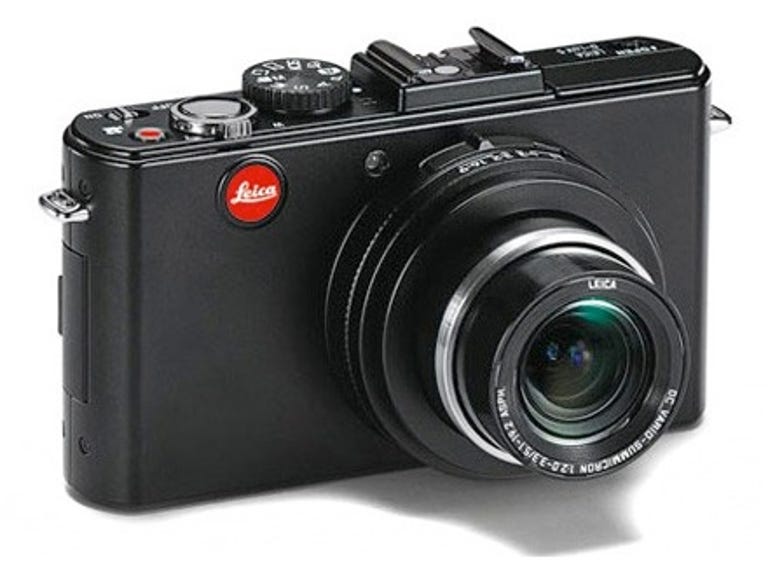 Why You Can Trust CNET
Why You Can Trust CNET Leica D-Lux 5 review: Leica D-Lux 5
The Leica D-Lux 5 compact camera is undeniably expensive. But its superior images, classic design and broad range of features go a long way towards justifying its price tag.
At around £620, the Leica D-Lux 5 compact camera certainly isn't cheap. But, with a solid spec list and classy appearance, the D-Lux 5 lets you get that famous 'Leica look' without forking out thousands of pounds on one of the German company's high-end digital SLRs.
The Good
The Bad
The Bottom Line
Join the dots
Mention the name 'Leica' and you'll hear plenty of talk about 'paying for the red dot'. The brand certainly has a reputation for exclusivity. But, leaving the price issue to one side for a moment, it's clear that the D-Lux 5 has plenty to offer the discerning photographer.
Its design, for instance, is a fabulous example of retro-modern engineering. Admittedly, there are much smaller, lighter compacts available, but few look quite like this. The D-Lux 5's distinctive shell brings to mind classic Leica models from times past, without getting too hung up on trying to look like an antique replica.
Tough, matte black, anodised metal covers most of the body, with hints of chrome highlighting various buttons and features. The overall effect is a near-seamless blend of classic and modern, with old-school mode dials and lens mountings rubbing shoulders with a giant, 3-inch LCD screen, and HDMI and USB output sockets hidden behind hinged doors.
Sensor excels
If you were to crack open the case -- and we don't suggest for a second that you do -- you'd find a relatively large (1/1.63-inch) CCD sensor with a top resolution of about 10.1 megapixels. In 4:3 format, this translates to a top resolution of 3,648x2,736 pixels. Again, this certainly isn't the highest pixel count available in a compact, but it's more than enough for prints of up to A3 size.
Photos can be saved as both JPEG and raw files for processing on your desktop PC. A full copy of Adobe Photoshop Lightroom (normally sold for around £230 as a standalone product ) is provided with the camera.

A number of alternative picture formats can be selected via a lens-mounted switch, allowing you to shoot in the 3:2, 16:9 and 1:1 aspect ratios, as well as standard 4:3. Video can be recorded at resolutions of up to 720p. The movie quality is quite good for a still camera, too. A dedicated video button and support for the AVCHD Lite codec help to make the movie mode more than just an afterthought.
A small amount of memory (40MB) comes built-in but isn't particularly useful for anything. Thankfully, the memory-card slot is compatible with high-capacity SDHC and SDXC cards, while the supplied battery is good for around 400 shots.
Seasoned pros may lament the absence of a viewfinder but it's possible to add an electronic one via the hotshoe, albeit at an additional cost of around £250 for Leica's own EVF 1. Those happy to work with the LCD, however, will find the display to be of above-average quality. Its 460,000-pixel resolution means there's plenty of sharp detail on show, and there's none of the under- or over-saturated colours common on cheaper screens.
The D-Lux 5 features Leica's own user interface. It's not bad but it's nowhere near as polished as the rest of the package. That's not to say it's in any way frustrating to use -- menus are laid out as you'd more or less expect and it's easy to navigate through the options. It's just that the on-screen text and graphics look rather low-fi compared to the rest of the product.
I Leica what I see
As you might expect from a Leica product, the D-Lux 5's lens is the real star of the show. The Leica DC Vario-Summicron 1:2-3.3/5.1-19.2mm ASPH zoom lens is fast, with a versatile focal range of 24-90 mm (35mm equivalent). At the wide end, the camera is great for group shots and landscapes and, while the 3.8x optical magnification isn't exactly excessive, it's enough for most situations.
The camera's low-light sensitivity is better than that of previous Leica compacts, pushing ISO figures right up to 12,800, with noise only starting to become an issue at around 800. A pop-up flash is available when it gets too dark.
The D-Lux 5's images have a curiously indefinable quality to them that's absent from a surprisingly large amount of digital-era photography. Rich colours, sharp focus, dynamic range and depth of field all combine to produce a warm, almost analogue feel. Macro and portrait shots look great, with accurate flesh tones and highly pleasing shallow-focus effects.
It's easy to get good results by just pointing and pressing the shutter button. Intelligent-auto, face-recognition, image-stabilisation and other such features are all present, just as you'd expect from a modern compact. The automatic functions are generally fast and reliable.
But there's also a great deal of scope for experimentation. The top-mounted dial switches the unit between modes. The aperture and shutter-priority modes are joined by scene modes, colour modes, custom settings and a full manual mode. There's no focus ring, but the manual controls are better on this camera than on most compact rivals, thanks to a context-sensitive thumb dial on the rear.
Conclusion
There are plenty of similarly specified compact cameras available that cost significantly less than the Leica D-Lux 5. But, while the D-Lux 5 is undeniably expensive, it's also an unquestionably excellent product. It looks good, feels great and produces images that are several dozen notches above those you can achieve with most cheap, crowd-pleasing compacts.
If you're looking for something to justify the extra expense, then the inclusion of the Adobe Photoshop Lightroom software should help, as should Leica's standard extended-warranty period of two years, and comprehensive customer support. The fact that Leica cameras tend to have a decent resale value may be of some comfort too.
When it comes down to it, though, you're either a Leica person or you're not. If you're someone who already uses the company's products, then the D-Lux 5 would make a good portable alternative to an existing dSLR. Alternatively, if you have a soft spot for the famous German brand but don't have the funds for, say, an M9, then the D-Lux 5 provides a taste of Leica for much less cash.
Edited by Charles Kloet


